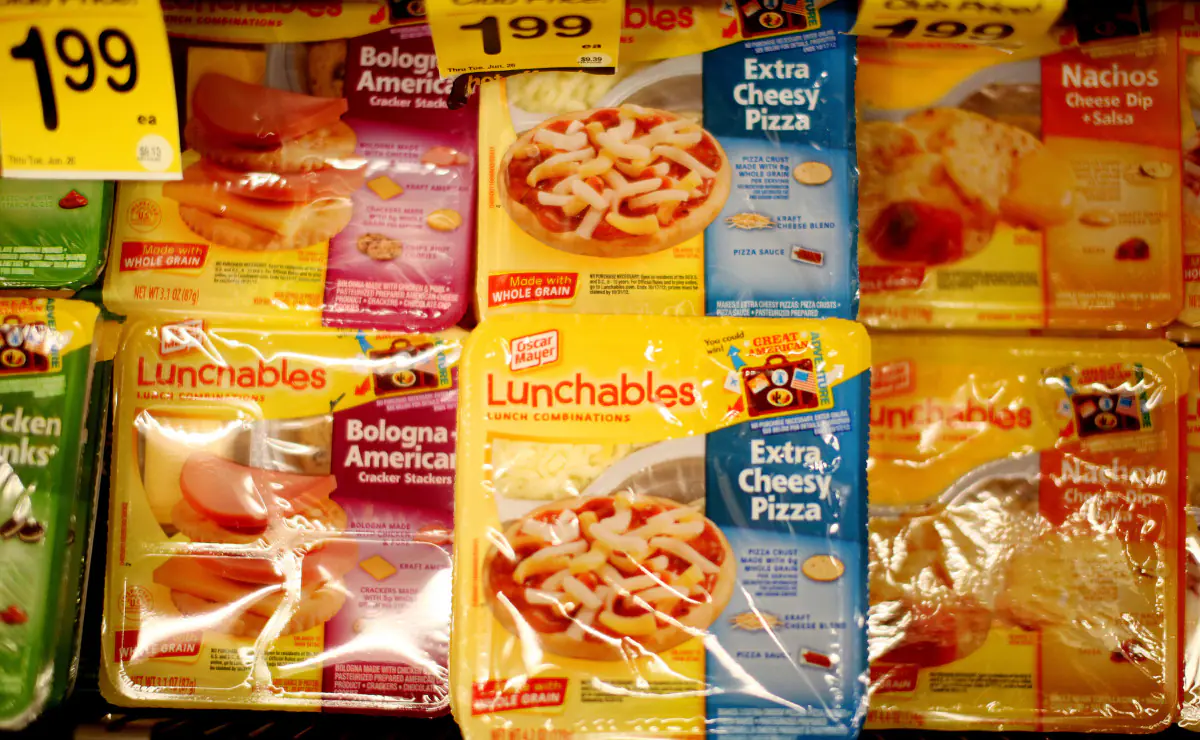A Lunchable Pizza contains approximately 380 calories. For lunch, a Lunchable Pizza provides a convenient and tasty option.
It is important to know the calorie content to make informed choices about your overall diet. Along with the pizza, Lunchables typically include sides like a small dessert, crackers, and a drink, making it a complete and satisfying meal.
Even though it may be convenient for busy people, it may be a convenient option for busy individuals. However, it is still crucial to consider its nutritional value and balance it with other nutrient-rich foods throughout the day. Understanding the calorie content allows you to make smart choices to meet your dietary needs and maintain a healthy lifestyle.
What Is A Lunchable Pizza?
A Lunchable Pizza is a convenient and ready-to-eat meal option that consists of mini pizza crusts, sauce, and toppings. The calorie count varies depending on the specific ingredients.
Lunchable Pizza is a ready-to-eat meal kit that provides a convenient and fun quick lunch or snack option. It is a popular product among children and adults alike due to its easy assembly and diverse components. Lunchable Pizzas are known for their simplicity of preparation, making them an ideal choice for busy individuals on the go.
Components And Packaging Of Lunchable Pizza:
When you open a Lunchable Pizza package, you will find the following components:
- Precooked pizza crust: The pizza crust is prebaked, providing a solid foundation for your lunchtime creation. It often has a crispy texture, adding an enjoyable crunch to every bite.
- Pizza sauce: The Lunchable Pizza kit includes a small container of tangy pizza sauce. This savory sauce is the base for building the pizza and adds flavor to your creation.
- Shredded cheese blend: Lunchable Pizza has a generous shredded cheese blend, usually a mixture of mozzarella and cheddar. The cheese adds gooeyness and richness to the pizza.
- Mini pepperoni slices: One of the highlights of Lunchable Pizza is the mini pepperoni slices. These bite-sized pepperoni pieces are perfect for layering on the pizza and provide a zesty and savory taste.
- Resealable packaging: Lunchable Pizza comes in a resealable package to ensure freshness and convenience. This feature allows you to store any uneaten portions and enjoy them later.
Brief History Of Lunchable Pizza:
Lunchables originated in the late 1980s as a revolutionary idea for convenient packed lunches. Kids and parents quickly embraced this innovative meal solution, and Lunchables gained immense popularity over the years. The introduction of Lunchable Pizza transformed the product line, offering a quick and easy pizza experience that could be enjoyed anytime, anywhere.
Lunchable Pizza has successfully evolved to cater to changing preferences and tastes. Today, Lunchables offers various options, including pizza toppings, crust types, and dessert components. It is a go-to choice for individuals seeking a hassle-free and delicious meal.
Lunchable Pizza blends convenience, versatility, and taste in one compact package, making it the perfect choice for those seeking a quick and enjoyable pizza experience.

Credit: www.pinterest.com
Unveiling The Nutritional Facts Of Lunchable Pizza
Discover the nutritional facts of Lunchable Pizza and find out just how many calories are packed into this popular lunch option. Understand the calorie content and make informed choices to meet your dietary goals.
Calories In Lunchable Pizza: An In-Depth Analysis
Lunchable Pizza, a popular snack among kids and adults alike, is convenient and packed with flavors. But have you ever wondered about the nutritional facts and calories in that little slice of goodness? Let’s dive deep into the nutritional content of Lunchable Pizza and uncover the truth!
Fat Content In Lunchable Pizza
- Total fat: Lunchable Pizza contains a moderate amount of fat. While fat is an essential nutrient for our body, consuming it in moderation is important.
- Saturated fat: Lunchable Pizza does contain saturated fat, which should be limited to a well-balanced diet for optimal health.
- Trans fat: Thankfully, Lunchable Pizza is free from trans fats, considered unhealthy and best avoided.
Protein And Carbohydrate Content In Lunchable Pizza
- Protein: Lunchable Pizza provides a good amount of protein for muscle growth and repair. Protein-packed snacks like this can be a great addition to your diet, especially for active individuals.
- Carbohydrates: Lunchable Pizza contains carbohydrates, the body’s primary energy source. However, it’s important to note that it also contains added sugars. While these sugars enhance the taste, consuming them in moderation is advisable.
In A Nutshell
- Lunchable Pizza, although a tasty treat, should be enjoyed in moderation due to its moderate fat content.
- It contains a small amount of saturated fat but no trans fats.
- The protein content is decent, making it a good snacking option for individuals looking for an energy boost.
- Remember to consume the carbohydrates in Lunchable Pizza in moderation, as they contain added sugars.
So next time you indulge in a Lunchable Pizza, you can make an informed decision about its nutritional value and enjoy it guilt-free as part of a balanced diet.
Comparing Lunchable Pizza With Homemade Pizza
Lunchable Pizza and homemade pizza differ in their calorie content. While the number of calories in Lunchable Pizza may vary, it generally contains more calories than a homemade pizza due to added preservatives and processed ingredients.
Lunchable Pizza and homemade pizza are two popular options for a quick and easy meal. While Lunchable Pizza offers convenience, You should consider the health implications of regularly consuming it. In this section, we’ll compare Lunchable Pizza with homemade pizza and explore the nutritional differences between the two.
Health Implications Of Consuming Lunchable Pizza Regularly:
- High in sodium: Lunchable Pizza has a high amount of sodium, which can increase blood pressure and negatively affect heart health.
- Processed ingredients: Lunchable Pizza typically includes processed meats and cheeses high in additives and preservatives. Regular consumption of these processed ingredients may have long-term health implications.
Tips For Making A Healthier Homemade Pizza:
- Opt for the whole wheat crust: Using whole wheat crust adds more fiber to your pizza and provides essential nutrients. It also helps promote better digestion and supports a healthy weight.
- Load up on veggies: Include a generous amount of colorful vegetables as toppings. Vegetables not only add flavor but also provide essential vitamins and minerals.
- Choose lean proteins: Swap processed meats with lean proteins like grilled chicken or turkey. These options are lower in fat and offer more nutritional value.
Nutritional Differences Between Lunchable Pizza And Homemade Pizza:
- Calories: Lunchable Pizza typically contains around X calories, while the calorie content of homemade pizza depends on the toppings and portion size.
- Fat content: Homemade pizza can be customized to lower fat using healthier oils, leaner proteins, and lighter cheeses. Lunchable Pizza often contains higher levels of unhealthy fats.
- Sodium: Homemade pizza can be prepared with less sodium by using low-sodium ingredients or reducing the amount of added salt. In comparison, Lunchable Pizza tends to have a higher sodium content.
While Lunchable Pizza offers convenience, it is important to be aware of the health implications of regular consumption. You can control the ingredients in homemade pizza, making it healthier. Homemade pizza can be delicious and nutritious with a whole wheat crust, plenty of vegetables, and lean proteins.
FAQs
A Lunchable Pizza contains approximately 320 calories. It is important to note that calorie content may vary slightly between different flavors and toppings.
Lunchable Pizzas are convenient and fun for kids but are not considered a healthy choice. These pizzas are high in sodium, saturated fat, and preservatives. It is recommended to consume them in moderation as an occasional treat rather than a regular part of the diet.
The ingredients in a Lunchable Pizza typically include a mini pizza crust, pizza sauce, cheese blend, and sometimes additional toppings such as pepperoni. Checking the packaging for specific ingredients and allergen information is always important.
Conclusion
To summarize, understanding the calorie content of Lunchable Pizza can help you make informed choices about your lunchtime options. With an average calorie count of around 500-600 calories per serving, it’s important to consider this as part of your daily calorie intake.
However, remember that individual calorie needs vary based on age, gender, activity level, and goals. If you aim to maintain a healthy weight or lose weight, tracking your calorie consumption and prioritizing a balanced diet is essential.
Incorporating fresh fruits, vegetables, and lean proteins alongside the occasional Lunchable Pizza can help promote a nutritious and satisfying meal plan. Additionally, paying attention to portion sizes and reading nutrition labels can further support your efforts to maintain a well-balanced and calorie-conscious diet.
By being mindful of your calorie intake, you can enjoy Lunchable Pizza as a convenient and tasty option without compromising your nutritional goals. So, remember to be mindful of your portion sizes and choose wisely to maintain a balanced and nutritious diet.

As the author of the “Ultimate Pizza Guide: Recipes, Tips & Secrets Revealed,” I’m dedicated to sharing my love for pizza and empowering others to create delicious homemade pizzas with ease. Join me on a journey to uncover the secrets to perfecting your pizza game!



